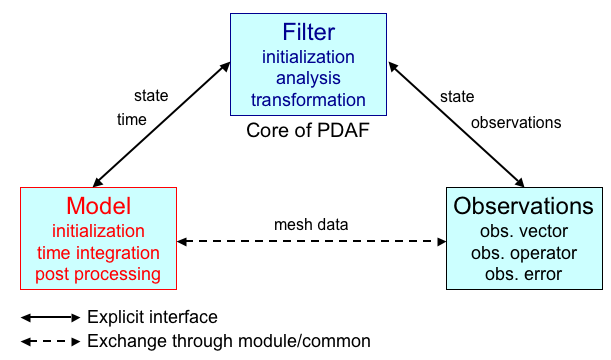| Version 22 (modified by , 7 months ago) ( diff ) |
|---|
General Implementation Concept of PDAF
Logical separation of the assimilation system
Implementation Concept
- General Concept
- Online Mode
- Offline Mode
Contents of this page
PDAF bases on the logical separation of the assimilation system in 3 parts. These are depicted in figure 1.

Figure 1: Logical structure of an assimilation system.
The parts of the assimilation system are
- Model:
The numerical model provides the initialization and integration of all model fields. It defines the dynamics of the system that is simulated. - Observations:
The observations of the system provide additional information. - Assimilation method:
The assimialtion methods combine the model and observational information.
Generally, all three components are independent. In particular, the assimilation methods are implemented in the core part of PDAF. To combine the model and observational information one has to define the relation of the observations to the model fields (For example, model fields might be directly observed or the observed quantities are more complex functions of the model fields. In addition, the observations might be at different locations than the model grid points so that interpolation is required.) In addition one has to fill the state vector that is using in the DA methods with the model fields and write the analysis state vector back to the model fields. These relations and operations are implemented in separate routines that are supplied to the assimilation system by the user. These routines are called through a well-defined standard interface. To ease the implementation complexity, these user-defined routines can be implemented like routines of the model code. Thus, if a user has experience with the model, it should be rather easy to extend it by the routines required for the assimilation system.
Online and offline assimilation systems
There are two possibilities to build a data assimilation system
- Online mode:
In this case, the model code is extended by calls to PDAF core routines. A single program is compiled. While running this single program, the necessary ensemble integrations and the actual assimilation are performed and the information transfer between the model and the data assimilation functions are performed in memory. - Offline mode:
The model is executed separately from the assimilation program. Output files from the model are used as inputs for the assimilation program, which writes restart files for the model after computing the analysis step.
PDAF supports both the online and offline modes. The online mode is usually more efficient on parallel computers, since less files have to be written to disks and the model does not need to be restarted after the analysis step. However, the required coding is simpler for the offline than the online mode, since no modification to the model source code is necessary.
The better efficiency of the online mode of the data assimilation system is caused by several factors:
- The initialization phase of the model program is executed only once
- The output files are limited to the necessary outputs for the estimated forecast and analysis states and/or ensembles. In contrast for the offline mode restart files have to be written and read for each forecast/assimilation cycle.
- The assimilation system for the online mode can make efficient use of a large number of processors by executing a single program containing the full assimilation system. In contrast, in the offline mode, separate programs for the forecasts and the assimilation have to be run, each of these use typically less processors.
The implementation concepts of the online and offline modes of PDAF are described on separate pages:
